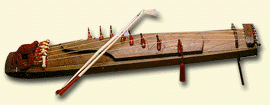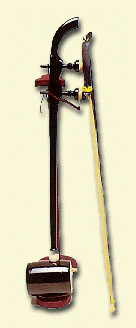|
|
|
¢Â Kayagum
(The Traditional Korean 12-Stringed Zither) ¢Â
|
|

|
|
Size
|
23cmx140cm(length)
|
|
Materials
|
upper board-paulownia wood, lower board-chestnut wood,
the finest silk- thread
|
|
Features
|
carefully selected materials, elaborating coating and
using best-quality silk-thread
|
|
The origin of the Kayagum goes back to the Three Han
Period of Korean history. Then, around 560 AD, King
Kashil of the Kaya Kingdom, influenced by the music
of Dang China, refined the instrument and ordered maestro
Uruk to compose twelve pieces for it. On the resonant
trunk made of paulownia tree, twelve strings are placed
supported by goose¡¯s foot shaped frets. The instrument
is divided into two kinds: "Jeong-ak (Beop-keum
or Poongryu)¡¯ Kayagum and "sanjo" Kayagum.
The former type sounds by pushing or filliping strings
while the latter sounds plucking or filliping. Kayagum
is widely regarded feminine instrument in that it has
a light and elegant sounds. The jeong-ak Kayagum is
used in the large-scale chamber music such as Yeomin-rak¡¯
or ¡®Pyungjo-Hoisang¡¯ or to accompany lyric songs or
¡®Se-ak¡¯ like ¡®Cheon-nyun Manse¡¯ or ¡®Boheo-sa¡¯. The sanjo
Kayagum is used in folk and improvisational musical
pieces such as sanjo (solo music with drum accompaniment)
and shinawi (improvisational ensemble music). Besides
these two kinds of gayakeum, there is reformed style
Kayagum equipped with broader compass and diverse sounds.
In Japan, Kayagum is known as Shilla-keum (or Shilla-gi-go-do)
on ground that it was introduced by the person of Shilla
Kingdom. At present, Shilla-keum is kept in Jeongchang-won
in Nara, Japan.
Poongryu Kayagum is often played to accompany lyric
song along with Komungo (a 6-stringed zither). Kayagum
sanjo is most famous instrument in Korea and abroad
due to the popularity of Sanjo in which Kayagum is played
as the solo instrument.
|
|
|
¢Â Komungo
(a 6-stringed zither) ¢Â
|
|

|
|
Size
|
23cmx165cm (long)
|
|
Materials
|
paulownia tree, chestnut tree and best quality silk-thread
|
|
Features
|
The instrument has a deep and resonating sound by using
the specially selected best-quality materials and thread.
|
|
Komungo or hyeon-geum, was invented around 550 AD by
Wang San-ak, a famous musician of the Koguryo Kingdom
who remodeled seven Hyun-geum of China and composed
many songs for his new instrument. When he played it
in the presence of the king, amazingly, a black crane
was fled there and danced to his songs. That¡¯s why they
called his instrument 'Hyun-hark-geum¡¯: crane string
instrument.' Later, it was changed as 'Komungo'. After
the United Shilla Kingdom, the instrument was handed
down. Many musicians including Ok-bo-go used it and
made it popular. It was one of Sam-hyun (three important
strings) in the era of United Shilla Kingdom along with
Kayagum and Dang-bipa.
On the resonant trunk made of paulownia tee, 6 silk
strings with different thickness are placed and 16 Gwae
(fret). The names of strings are Dae-hyun, Mun-hyun,
Mu-hyun, Gwaesang-cheong, Gigwae-cheong and Yu-hyun
in the order of thickness. The front face is made of
paulownia wood and the rear face, hard chestnut wood.
The plectrum is made of bamboo grown beside sea.
The method of performance is that the fingers of left
hand place on the Gwae for control of pitch and the
right hand makes sound by beating or plucking the strings
with a stick called 'Sul-Dae' grasped between the index
finger and the middle finger.
|
|
|
¢Â Ajaeng
(seven-string zither) ¢Â
|
|

|
|
Size
|
39cm(long)x130cm(wide)
|
|
Materials
|
Paulownia wood and best-quality silk-thread
|
|
Features
|
Using hard paulownia wood and best-quality silk-thread
make heavy and magnificent sound possible.
|
|
Ajaeng was introduced to Korea from Ming, China in
1389 during the reign of King Kongyang of the Koryo
dynasty, and later remodeled during the reign of King
Sejong of the Chosun dynasty. The materials are the
same as those of the Komungo (a 6-stringed zither) or
Kayagum. Ajaeng has 7 to 9 strings with different thickness
supported frets and play on the support called ¡®Chosang¡¯.
Its bow is made of a peeled branch of forsythia painted
with pine resin.
Ajaeng is classified into two kinds at present :Jeong-ak
and Minsok-ak.
The former style Ajaeng sounds rough but magnificent,
wide and heavy. Since it produces the most heavy sound
of all traditional instruments, it creates fantastic
atmosphere and use in ensemble of A-ak or ensemble of
wind instruments like Boheoja (Waling in the void),
Nagyangch¡¯un (Spring in Loyang), Samhyunyoungsang-Hoisang
and Dong-dong. It also plays in the large-scale concert
of wind and string instruments like Yomillak (Enjoyment
with the people) and Pyungjo-hoi-sang etc. Sanjo Ajaeng
is used in ensemble of folk music as well as solo instrument.
In Koryo dynasty, ajaeng only played in Dang-ak(a kind
of national music which was based on Chinese music),
but since the reign of King Sungjong of Chosun dynasty,
it have used in both Dang-ak and Haying-ak(a kind of
folk music).
|
|
|
¢Â Haegeum
(Two-string fiddle) ¢Â
|
|

|
|
Size
|
12cm(long)x67cm(wide)
|
|
Materials
|
Resonant trunk made of bamboo root and best-quality
silk-thread
|
|
Features
|
UBy using best quality bamboo root and silk-thread,
the instrument¡¯s specific soft and clean sound is made.
|
|
Haegeum is an instrument introduced from Sung, China
in 1114 AD during the reign of King Yejong of the Koryo
dynasty. On top of a small resonant trunk with a diameter
of about 10 centimeters, there is a bamboo stick that
is about 66 centimeters in length. And on the stick
are two strings, which are supported by ¡®Wonsan¡¯. A
bow made of horsehair coated with pine resin. By holding
this bow in the right hand, the performer makes sound
by rubbing the bow against these strings. It is amazing
how much diverse timbre it produces only with these
two strings.
After its introduction, it was used for both Hyang-ak
and Dang-ak, but, according to the book
written in the period of King Sungjong of the Chosun
dynasty, it only used in Hyang-ak and called ¡®Danggu¡¯.
It can produce high and low pitched sound freely. Its
soft and clean sound fascinates peoples¡¯ mind.
This instrument is most widely used in traditional music
performance both in Jeong-ak(chamber music) and folk
music like Hapju, Sanjo and Gagok (lyric song) as an
accompaniment. It is classified in string instrument,
but always played in the part of wind instrument.
|
|

|
